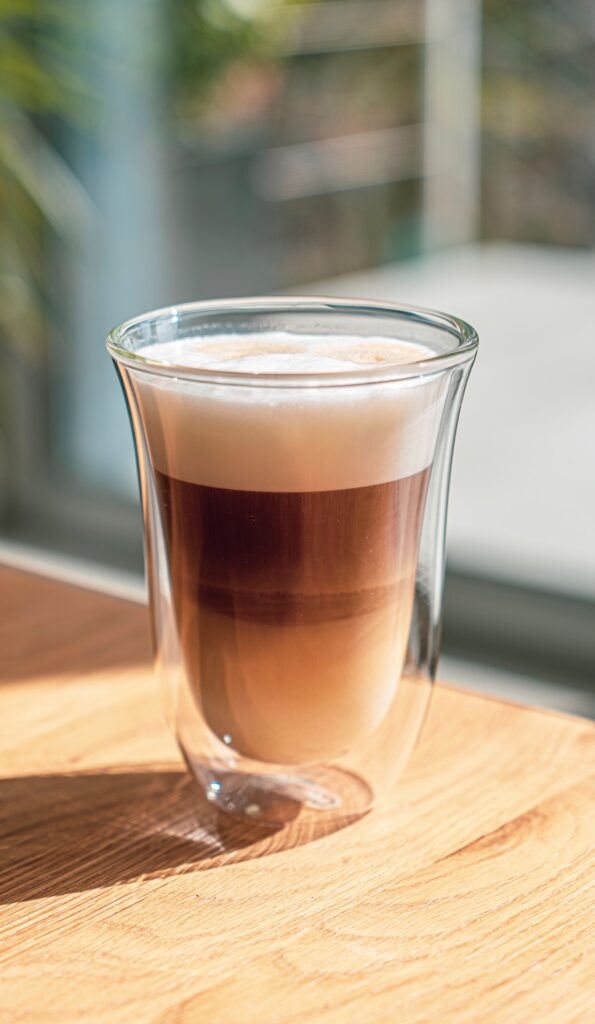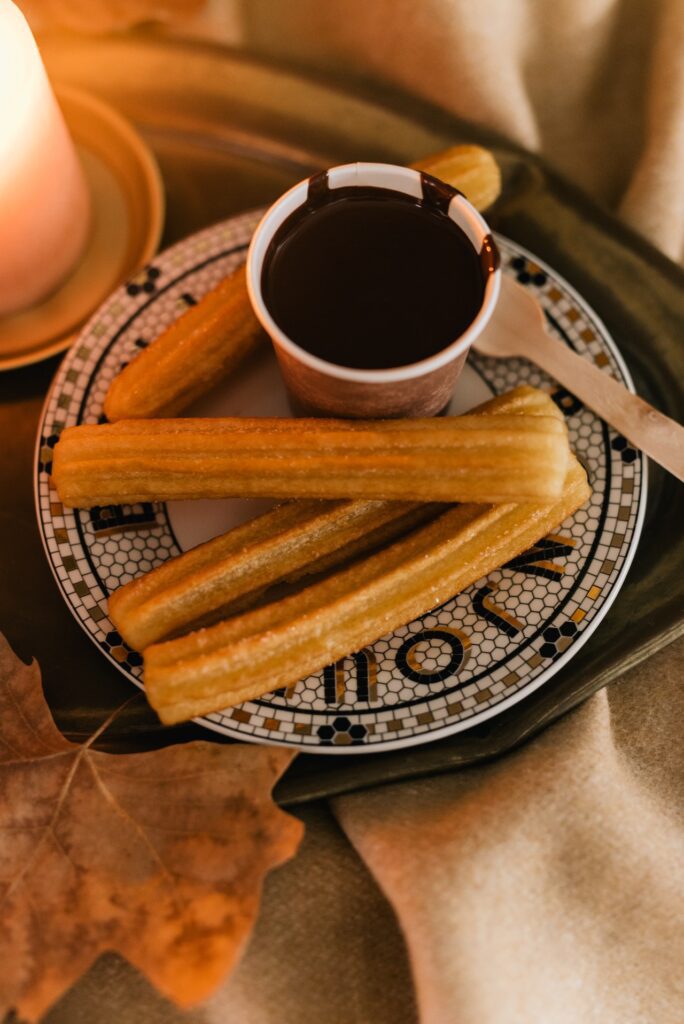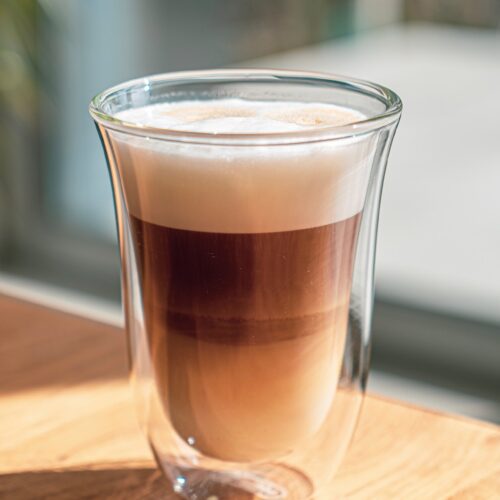Of all the countries I have visited, few have come close to the experience of Spain. It’s a country filled to bursting with passion and vibrancy. Spanish people are known for their outgoing personalities and love of life. They celebrate their lives with food, music, and dance. Whenever I’m missing the heat, intensity and joy of Spain I have to make a Spanish latte.

Also known as a café con Leche, drinking a Spanish latte is a deep and brooding experience, from the smells and texture through to the taste, which embodies the spirit of Spain.
Making a Spanish latte is super simple, but fills you with passion, commitment and love. And once you’ve tried one, It will just make you want to travel through Spain soaking up the sights, sounds and flavors.
What is a Spanish latte (café con leche)
It starts with a dark roast espresso shot (or two). Over that is poured scalded milk. then, typically, the Spanish add a lot of sugar and sometimes, a sprinkle of fresh ground cinnamon.
Why are so many robust flavors combined into this latte? Well, in Spain, it’s traditional latte is normally drunk first thing in the morning. So it gives you an instant energy boost to help you to hit the day with everything you have. Imagine yourself in Spain, about to step into your busy day, and you will see why the Spanish choose Spanish latte.
They are becoming increasingly popular in coffee shops across the country due to their unique flavor profile and ability to give you an instant energy boost from the combination of caffeine and sugars.
What is scalded milk?
Scalding sounds like it would ruin the milk. But, it’s a method of pasteurization used to make milk safe for consumption. It has been in use for centuries in rural areas, both before and since the widespread use of pasteurisation.
Scalded milk is made by heating milk to a temperature of 180-185°F (82-85°C). Just don’t let the milk reach boiling point (212 °F (100 °C)) as that will make it curdle. If it gets that hot, safely discard the milk and start again.
Why scald milk?
Scalding milk not only helps reduce lactose levels, making it easier to digest for people with lactose intolerance, it also produces a sweeter, nuttier, taste than regular milk. That’s because scalding increases the concentration of certain sugars such as glucose and maltose, which adds natural sweetness to the milk. Additionally, scalding denature some of the proteins and reduces the milk’s viscosity, resulting in a smoother texture.
Apart from making a unique coffee, scalded milk makes for an interesting change from ordinary pasteurised milk. It works well in many dishes such as custards, sauces, ice cream and cereals. You can even drink it by itself.
Top Tip: If you aren’t using it immediately, allow it to cool and then keep it in the fridge. Plus scalded milk should be consumed within 1 to 2 days of scalding and refrigerated if you intend to keep it for more than a few hours.
Why are Spanish lattes so sweet?
There are two main reasons why Spanish lattes taste so sweet. the process of scalding milk makes it sweeter. Plus, the traditional way of serving it in Spain is with plenty of sugar.


So why do the Spanish drink it so sweet? Well, until recently Spain was a largely rural agricultural economy. With many people working the land, they needed an early morning boost of energy. Hence the Spanish love a breakfast of churros with chocolate, washed down with café con Leche. Just in case you’ve not heard of them, churros are made from donut dough but are shaped like sticks and served with heated dark chocolate to use as a dip.
Add in a double shot of espresso you are in for a truly seductive experience. Allow the experience to saturate your taste buds and imagine you are off for a long day toiling in hot temperatures to work off the calories. Or maybe, just relax and enjoy!.
Best coffee beans for Spanish latte
There are many different types of espresso coffee beans that can be used to make Spanish espresso. However, some beans are better suited to this type of coffee than others.
When I make a Spanish latte, the first thing I think of is all the competing flavours: the sweet nutty milk and even more sweetness from the added sugar. So I immediately reach for a full-strength dark roast espresso. When I need robust, full-flavored, espresso beans my favorite brands are:
- Death Wish Coffee
- Atomic Dog Coffee
- Koffee Kult Dark Roast Coffee Beans
You won’t go wrong with these bad boys.
Grinding coffee for a Spanish latte
If you are using an espresso machine to make your espresso, it’s important to use a coffee grinder that can provide a consistently fine grind. This will help the machine extract all of the flavors from the beans, creating a rich, robust cup of coffee. If you do not have a coffee grinder, you can use pre-ground coffee. It’s not the best solution, but when you want a Spanish latte you have to do what you can with what you have available.
Brewing coffee for Spanish latte
Spanish latte starts with a shot, or two, of espresso. If you have one, use an espresso machine. If you don’t have an espresso machine check out How to make espresso without a machine. this will talk you through how to make espresso using all the popular methods.
With an espresso machine
- Brewing coffee for espresso is a process that takes some time and practice to perfect, but it is well worth the effort. The steps are:
- Start the espresso machine and allow it to heat up for a few minutes
- Place fresh fine-ground coffee into the portafilter and tamp it down firmly
- Insert the portafilter and brew the espresso shot.
- Use immediately as part of your cafe con Leche.
Making Spanish latte at home
Feel the need for an energy boost, but too tired to make a run to your favorite coffee shop? The answer is to make your own Spanish latte
Equipment
- Espresso machine or coffee maker
- saucepan or microwave safe jug
- food thermometer
- glass or mug
- spoon
Ingredients
- ½ cup whole cow’s milk
- 2 shots espresso
- 1-2 tsp sugar (optional)
- 1 pinch ground cinnamon (optional)
Method
- Brew 1-2 shots of espresso coffee, using an espresso machine or coffee maker.
- While the coffee is brewing, scald 1/2 cup of milk in either a microwave or on the stovetop.
- Once the espresso is ready, pour it into a shot into a glass or mug.
- Slowly pour the scalded milk on top of the espresso
- Add sugar, start by adding 1-2 teaspoons. You can always add more
- Finally, you can optionally sprinkle with cinnamon and serve
- Enjoy!
Top Tips for making Spanish latte at home
Begin by making an espresso shot. If you are using an espresso machine, refer to your machine’s manual for brewing instructions. Otherwise, take a look at How to make espresso without a machine. While the coffee is brewing Scald the milk. There are two easy ways to do this:
Scalding milk in a microwave
- Pour cold whole cow’s milk into a microwavable safe jug.
- Heat it in the microwave on high for 1/2 minute.
- Remove from the microwave, stir to ensure the heat is evenly distributed, and then check the milk temperature with a milk thermometer.
- If the milk hasn’t reached 180-185°F (82-85°C) repeat the process of heating in the microwave for 1/2minute at a time and then check the temperature.
- Once it reaches 180°C it’s ready to use.
Top Tip 1: As with all things you heat in a microwave, take care not to burn yourself when handling the jug of hot milk. Top Tip 2: Don’t let the milk reach boiling point (212°F(100°C)) as that will make it curdle. If it gets that hot, safely discard the milk and start again.
Scalding milk in a stovetop pan
- Pour cold whole cow’s milk into a milk pan or other small saucepan
- Put it on to the stove and adjust the heat to a medium level, you need to be able to keep a check on the temperature AND not allow the milk to boil.
- Stir the milk continuously to ensure it doesn’t catch.
- Once it reaches 180-185°F (82-85°C) remove it from the heat and set it aside until ready to use.
Top Tip: Don’t let the milk reach boiling point (212°F(100°C)) as that will make it curdle. If it gets that hot, safely discard the milk and start again.
Assembling your Spanish latte
- Pour the espresso shot into a glass or mug.
- Slowly pour the scalded milk on top of the espresso
- Add sugar, start by adding 1-2 teaspoons. You can always add more
- Finally, you can optionally sprinkle with cinnamon and serve.
- Enjoy!
FAQs
What is the difference between a Spanish latte and a regular latte
The main difference between a Spanish latte and a regular latte lies in the ingredients used to make them. Regular lattes are usually made with espresso and steamed milk, while Spanish lattes use scalded milk instead. Scalding involves heating the milk to just below its boiling point, resulting in a creamier texture and foam. The scalded milk also has a slightly sweeter taste than steamed milk, making the Spanish latte particularly flavorful. Additionally, it’s common for baristas to add spices such as nutmeg or cinnamon to a Spanish latte for extra flavor. Overall, this makes the Spanish latte an ideal choice for those who enjoy an indulgent latte with a unique taste
However, scalding the milk also requires more time and effort than simply steaming it. This means that Spanish lattes may take longer to prepare than a regular latte, so it’s important to factor in this extra time if you are ordering one.
Is there more caffeine in a Spanish latte than other lattes
The caffeine content of a Spanish latte may vary depending on the size and ingredients used to make it. Compared to other lattes, a Spanish lattes typically contain the same amount of caffeine and because all lattes are made with espresso shots rather than regular brewed coffee.
Can I make a Spanish latte with any type of milk?
No, to make an authentic Spanish latte you must use cow’s milk. The scalding process, unique to this latte, breaks down some proteins and reduces the viscosity of the milk, resulting in a smoother texture. At the same time, it works to increase the intensity of the natural sugars. The result is that scalded milk is smoother and sweeter, with a pleasing nuttiness to its flavor.
What’s the difference between a Spanish latte and a regular latte?
The main difference is that Spanish latte is made with scalded milk instead of the foamed milk most other lattes use.
The only downside of a café con Leche is that they are not great for latte art. That’s because the scalding process breaks down the proteins and makes it impossible to foam the milk.
Different types of lattes you can make at home
Looking for the ultimate list of lattes? Look no further than Types of lattes: 22 very best lattes you must try. But if want to go direct to some of the very best lattes that you can easily make and enjoy at home, check out:
- Iced caramel latte recipe
- Hazelnut latte recipe
- Vanilla latte recipe
- Honey latte – so sweet and so good!
- Oat milk latte
- Iced blond vanilla latte


Spanish latte recipe: spirit of the matador
- 1 Espresso machine or coffee maker
- 1 saucepan or microwave safe jug
- 1 food thermometer
- 1 glass or mug
- 1 spoon
- ½ cup whole cow's milk
- 2 shots espresso
- 1-2 tsp sugar
- 1 pinch ground cinnamon optional
- Brew 1-2 shots of espresso coffee, using an espresso machine or coffee maker
- While the coffee is brewing, scald 1/2 cup of milk in either a microwave or on the stovetop
- Once the espresso is ready, pour it into a shot into a glass or mug
- Slowly pour the scalded milk on top of the espresso
- Add sugar, start by adding 1-2 teaspoons. You can always add more
- Finally, you can optionally sprinkle with cinnamon and serve
- Enjoy!
Top Tips for making Spanish latte at home
Begin by making an espresso shot. If you are using an espresso machine, refer to your machine’s manual for brewing instructions. Otherwise, take a look at How to make espresso without a machine. While the coffee is brewing Scald the milk. There are two easy ways to do this:Scalding milk in a microwave
- Pour cold whole cow’s milk into a microwavable safe jug.
- Heat it in the microwave on high for 1/2 minute.
- Remove from the microwave, stir to ensure the heat is evenly distributed, and then check the milk temperature with a milk thermometer.
- If the milk hasn’t reached 180-185°F (82-85°C) repeat the process of heating in the microwave for 1/2minute at a time and then check the temperature.
- Once it reaches 180°C it’s ready to use.
Scalding milk in a stovetop pan
- Pour cold whole cow’s milk into a milk pan or other small saucepan
- Put it on to the stove and adjust the heat to a medium level, you need to be able to keep a check on the temperature AND not allow the milk to boil.
- Stir the milk continuously to ensure it doesn’t catch.
- Once it reaches 180-185°F (82-85°C) remove it from the heat and set it aside until ready to use.
Assembling your Spanish latte
- Pour the espresso shot into a glass or mug.
- Slowly pour the scalded milk on top of the espresso
- Add sugar, start by adding 1-2 teaspoons. You can always add more
- Finally, you can optionally sprinkle with cinnamon and serve.
- Enjoy!
All nutritional information is an estimate only, based on third-party calculations derived from an online nutritional calculator, Spoonacular API. The data provided is a courtesy and should not be considered a guarantee or fact. Each recipe and nutritional value will vary depending on the ingredients and brands you use, your measuring methods and portion sizes. For accurate results, we recommend that you calculate the nutritional information yourself, using a preferred nutritional calculator or advice from a nutritionist, based on your ingredients and individual processes.
Hi, I’m Eric Loftuss, co-founder of Bean Thirst with my wife Sophie.
My Coffee journey started young. I used to help my mom with the weekly shopping trip and we always called in to a coffee wholesaler and retail outlet in our town.
I really started to learn about coffee when, while in college, I worked in a local coffee shop and trained as a barista. Even though I went on to qualify and work as a lawyer, I still get a kick out of brewing a cup of Joe.
Sophie and I are so glad to be part of your coffee journey. Find out more about us
